Maintenance of Passive House Standard in the Light of Long-Term Study on Energy Use in a Prefabricated Lightweight Passive House in Central Europe
Abstract
1. Introduction
2. Materials and Methods
2.1. Case Study
2.2. Experimental Research
3. Results and Discussion
3.1. Outdoor and Indoor Temperature
3.1.1. External Air Temperature
3.1.2. Internal Air Temperature
3.2. Heat Pump—Energy Consumption for Heating and DHW
3.3. Circulation Pump of Floor Heating and Ventilation Air Heating Systems
3.4. Heat Recovery Unit
3.5. Total Energy Consumption
4. Conclusions
Author Contributions
Funding
Acknowledgments
Conflicts of Interest
References
- The European Parliament and the Council of the European Union. Directive (EU) 2018/844 of the European Parliament and of the Council of 30 May 2018 Amending Directive 2010/31/EU on the Energy Performance of Buildings and Directive 2012/27/EU on Energy Efficiency; The European Parliament and the Council of the European Union: Brussels, Belgium, 2018. [Google Scholar]
- Mahdavi, A.; Doppelbauer, E. A performance comparison of passive and low-energy buildings. Energy Build. 2010, 42, 1314–1319. [Google Scholar] [CrossRef]
- Marszal, A.; Heiselberg, P.; Bourrelle, J.; Musall, E.; Voss, K.; Sartori, K.; Napolitano, A. Zero Energy Building-A review of definitions and calculation methodologies. Energy Build. 2011, 43, 971–979. [Google Scholar] [CrossRef]
- Berardi, U. Clarifying the new interpretations of the concept of sustainable building. Sustain. Cities Soc. 2012, 8, 72–78. [Google Scholar] [CrossRef]
- Sadineni, S.; Madala, S.; Boehm, R. Passive building energy savings: A review of building envelope components. Renew. Sustain. Energy Rev. 2011, 15, 3617–3631. [Google Scholar] [CrossRef]
- Shameri, M.; Alghoul, M.; Sopian, K.; Zain, M.; Elayeb, O. Perspectives of double skin facade systems in buildings and energy saving. Renew. Sustain. Energy Rev. 2011, 15, 1468–1475. [Google Scholar] [CrossRef]
- Pacheco, R.; Ordóñez, J.; Martínez, G. Energy efficient design of building: A review. Renew. Sustain. Energy Rev. 2012, 16, 3559–3573. [Google Scholar] [CrossRef]
- Lu, Y.; Wang, S.; Shan, K. Design optimization and optimal control of grid-connected and standalone nearly/net zero energy buildings. Appl. Energy 2015, 155, 463–477. [Google Scholar] [CrossRef]
- Altobello, A.; Misceo, M.; Russo, P.; Stefanizzi, P.; Vignola, I. Comparison of numerical and experimental performances of nZEB residential building in Putignano (Apulia Region). In Proceedings of the IOP Conference Series: Materials Science and Engineering, Palembang, Indonesia, 15–16 October 2019; Volume 609, p. 072033. [Google Scholar]
- Rey-Hernández, J.M.; Velasco-Gómez, E.; San José-Alonso, J.F.; Tejero-González, A.; Rey-Martínez, F.J. Energy Analysis at a Near Zero Energy Building. A Case-Study in Spain. Energies 2018, 11, 857. [Google Scholar] [CrossRef]
- Chauhan, A.; Saini, R. A review on integrated renewable energy system based power generation for stand-alone applications: Configurations, storage options, sizing methodologies and control. Renew. Sustain. Energy Rev. 2014, 38, 99–120. [Google Scholar] [CrossRef]
- Bajpai, P.; Dash, V. Hybrid renewable energy systems for power generation in stand-alone applications: A review. Renew. Sustain. Energy Rev. 2012, 16, 2926–2939. [Google Scholar] [CrossRef]
- Ahmed, K.; Carlier, M.; Feldmann, C.; Kurnitski, J. A New Method for Contrasting Energy Performance and Near-Zero Energy Building Requirements in Different Climates and Countries. Energies 2018, 11, 1334. [Google Scholar] [CrossRef]
- Rey-Hernández, J.M.; Velasco-Gómez, E.; San José-Alonso, J.F.; Tejero-González, A.; González-González, S.L.; Rey-Martínez, F.J. Monitoring Data Study of the Performance of Renewable Energy Systems in a Near Zero Energy Building in Spain: A Case Study. Energies 2018, 11, 2979. [Google Scholar] [CrossRef]
- Baos, R.; Manzano-Agugliaro, F.; Montoya, F.; Gil, C.; Alcayde, A.; Gmez, J. Optimization methods applied to renewable and sustainable energy a review. Renew. Sustain. Energy Rev. 2011, 15, 1753–1766. [Google Scholar]
- Pezzini, P.; Gomis-Bellmunt, O.; Sudri-Andreu, A. Optimization techniques to improve energy efficiency in power systems. Renew. Sustain. Energy Rev. 2011, 15, 2028–2041. [Google Scholar] [CrossRef]
- Kampelis, N.; Sifakis, N.; Kolokotsa, D.; Gobakis, K.; Kalaitzakis, K.; Isidori, D.; Cristalli, C. HVAC Optimization Genetic Algorithm for Industrial Near-Zero-Energy Building Demand Response. Energies 2019, 12, 2177. [Google Scholar] [CrossRef]
- Xu, X.; Feng, G.; Chi, D.; Liu, M.; Dou, B. Optimization of Performance Parameter Design and Energy Use Prediction for Nearly Zero Energy Buildings. Energies 2018, 11, 3252. [Google Scholar] [CrossRef]
- Chastas, P.; Theodosiou, T.; Kontoleon, K.J.; Bikas, D. The Effect of Embodied Impact on the Cost-Optimal Levels of Nearly Zero Energy Buildings: A Case Study of a Residential Building in Thessaloniki. Greece Energies 2017, 10, 740. [Google Scholar] [CrossRef]
- Wan, K.; Li, D.; Liu, D.; Lam, J. Future trends of building heating and cooling loads and energy consumption in different climates. Build. Environ. 2011, 46, 223–234. [Google Scholar] [CrossRef]
- Giannakopoulos, C.; Hadjinicolaou, P.; Zerefos, C. Changing energy requirements in the Mediterranean under changing cimatic conditions. Energies 2009, 2, 805–815. [Google Scholar] [CrossRef]
- Ballarini, I.; De Luca, G.; Paragamyan, A.; Pellegrino, A.; Corrado, V. Transformation of an Office Building into a Nearly Zero Energy Building (nZEB): Implications for Thermal and Visual Comfort and Energy Performance. Energies 2019, 12, 895. [Google Scholar] [CrossRef]
- Patiño-Cambeiro, F.; Armesto, J.; Patiño-Barbeito, F.; Bastos, G. Perspectives on Near ZEB Renovation Projects for Residential Buildings: The Spanish Case. Energies 2016, 9, 628. [Google Scholar] [CrossRef]
- PASSIPEDIA. What is a Passive House? Available online: https://passipedia.org/basics/what_is_a_passive_house (accessed on 27 December 2019).
- Lang, A. Defining the Nearly Zero Energy Building, Passive House Institute. Available online: https://passreg.eu/upload/PassREg_International_EN/Flipbook.pdf (accessed on 27 December 2019).
- Passive House Institute (PHI). Available online: https://passivehouse.com (accessed on 27 December 2019).
- The 3D Modeling Tool for the PHPP: Design, PH. Available online: https://passivehouse.com/04_phpp/05_designph/05_designph.htm (accessed on 6 April 2020).
- Passive House Planning Package. Available online: https://passivehouse.com/04_phpp/04_phpp.htm (accessed on 6 April 2020).
- Colclough, S.; Kinnane, O.; Hewitt, N.; Griffiths, P. Investigation of nZEB social housing built to the Passive House standard. Energy Build. 2018, 179, 344–359. [Google Scholar] [CrossRef]
- Ekström, T.; Blomsterberg, Å. Renovation of Swedish Single-family Houses to Passive House Standard–Analyses of Energy Savings Potential. Energy Procedia 2016, 96, 134–145. [Google Scholar] [CrossRef]
- Feist, W. Forschungsprojekt Passive Häuser; Institut Wohnen und Umwelt: Darmstadt, Germany, 1998; ISBN 978-392-265-385-1. [Google Scholar]
- Feist, W. The Passive House in Darmstadt-Kranichstein—Planning, Construction, Results; Technical Information PHI: Darmstadt, Germany, 1997. [Google Scholar]
- Feist, W.; Peper, S.; Görg, M. CEPHEUS Final Publical Report; PHI: Hanover, Germany, 2001; Available online: https://www.phius.org/media/W1siZiIsIjIwMTEvMTIvMjIvMTBfMDFfNTBfOTk2X0NFUEhFVVNfZmluYWxfbG9uZy5wZGYiXV0?sha=a0c58caa (accessed on 8 April 2020).
- Feist, W.; Schnieders, J.; Dorer, V.; Haas, A. Re-inventing air heating: Convenient and comfortable within the frame of the Passive House concept. Energy Build. 2005, 37, 1186–1203. [Google Scholar] [CrossRef]
- Schnieders, J.; Hermelink, A. CEPHEUS results: Measurements and occupants’ satisfaction provide evidence for Passive Houses being an option for sustainable building. Energy Policy 2006, 34, 151–171. [Google Scholar] [CrossRef]
- Schnieders, J. CEPHEUS—Measurement Results from More Than 100 Dwelling Units in Passive Houses; Passive House Institute: Darmstadt, Germany, 2003; Available online: https://pdfs.semanticscholar.org/fdac/fb2ab84094028f506e9b5fc9454b7a706dd3.pdf?_ga=2.140378427.946716576.1584827443-603835346.1584827443 (accessed on 6 April 2020).
- Ridley, I.; Clarke, A.; Bere, J.; Altamirano, H.; Lewis, S.; Durdev, M.; Farr, A. The monitored performance of the first new London dwelling certified to the Passive House standard. Energy Build. 2013, 63, 67–78. [Google Scholar] [CrossRef]
- Ridley, I.; Bere, J.; Clarke, A.; Schwartz, Y.; Far, A. The side by side in use monitored performance of two passive and low carbon Welsh houses. Energy Build. 2014, 82, 13–26. [Google Scholar] [CrossRef]
- Rohdin, P.; Molin, A.; Moshfegh, B. Experiences from nine passive houses in Sweden–indoor thermal environment and energy use. Build. Environ. 2014, 71, 176–185. [Google Scholar] [CrossRef]
- Schnieders, J.; Feist, W.; Rongen, L. Passive Houses for different climate zones. Energy Build. 2015, 105, 71–87. [Google Scholar] [CrossRef]
- Mlakar, J.; Štrancar, J. Overheating in residential passive house: Solution strategies revealed and confirmed through data analysis and simulations. Energy Build. 2011, 43, 1443–1451. [Google Scholar] [CrossRef]
- Kaklauskas, A.; Rute, J.; Zavadskas, E.; Daniuna, A.; Pruskus, V.; Bivainis, J.; Plakys, V. Passive House model for quantitative and qualitative analyses and its intelligent system. Energy Build. 2012, 50, 7–18. [Google Scholar] [CrossRef]
- Langer, S.; Bekö, G.; Bloom, E.; Widheden, A.; Ekbe, L. Indoor air quality in passive and conventional new houses in Sweden. Build. Environ. 2015, 93, 92–100. [Google Scholar] [CrossRef]
- Fokaides, P.; Christoforou, E.; Ilic, M. Performance of a Passive House under subtropical climatic conditions. Energy Build. 2016, 133, 14–31. [Google Scholar] [CrossRef]
- Dahlstrøm, O.; Sørnes, K.; Eriksen, S.; Hertwich, E. Life cycle assessment of a single-family residence built to either conventional-or passive house standard. Energy Build. 2012, 54, 470–479. [Google Scholar] [CrossRef]
- Proietti, S.; Sdringola, P.; Desideri, U.; Zepparelli, F.; Masciarelli, F.; Castellani, F. Life Cycle Assessment of a passive house in a seismic temperate zone. Energy Build. 2013, 64, 463–472. [Google Scholar] [CrossRef]
- Badea, A.; Baracu, T.; Dinca, C.; Tutica, D.; Grigore, R.; Anastasiu, M. A life-cycle cost analysis of the passive house ‘POLITEHNICA’ from Bucharest. Energy Build. 2014, 80, 542–555. [Google Scholar] [CrossRef]
- Galvin, R. Are passive houses economically viable? A reality-based, subjectivist approach to cost-benefit analyses. Energy Build. 2014, 80, 149–157. [Google Scholar] [CrossRef]
- Stephan, A.; Crawford, R.H.; Myttenaere, K. A comprehensive assessment of the life cycle energy demand of passive houses. Appl. Energy 2013, 112, 23–34. [Google Scholar]
- Chel, A.; Janssens, A.; De Paepe, M. Thermal performance of a nearly zero energy passive house integrated with the air–air heat exchanger and the earth?water heat exchanger. Energy Build. 2015, 96, 53–63. [Google Scholar] [CrossRef]
- Kylili, A.; Fokaides, P. European smart cities: The role of zero energy buildings. Sustain. Cities Soc. 2015, 15, 86–95. [Google Scholar] [CrossRef]
- Georges, L.; Skreiberg, Ø.; Novakovic, V. On the proper integration of wood stoves in passive houses: Investigation using detailed dynamic simulations. Energy Build. 2013, 59, 203–213. [Google Scholar] [CrossRef]
- Rekstad, J.; Meir, M.; Murtnes, E.; Dursun, A. A comparison of the energy consumption in two passive houses, one with a solar heating system and one with an air-water heat pump. Energy Build. 2015, 96, 149–161. [Google Scholar] [CrossRef]
- Moran, F.; Blight, T.; Natarajan, S.; Shea, A. The use of Passive House Planning Package to reduce energy use and CO2 emissions in historic dwellings. Energy Build. 2014, 75, 216–227. [Google Scholar] [CrossRef]
- Leardini, P.; Manfredini, M.; Callau, M. Energy upgrade to Passive House standard for historic public housing in New Zealand. Energy Build. 2015, 95, 211–218. [Google Scholar] [CrossRef]
- Sage-Lauck, J.; Sailor, D. Evaluation of phase change materials for improving thermal comfort in a super-insulated residential building. Energy Build. 2014, 79, 32–40. [Google Scholar] [CrossRef]
- Němeček, M.; Kalousek, M. Influence of thermal storage mass on summer thermal stability in a passive wooden house in the Czech Republic. Energy Build. 2015, 107, 68–75. [Google Scholar] [CrossRef]
- Radoń, J.; Wąs, K.; Flaga-Maryanczyk, A.; Schnotale, J. Experimental and theoretical study on hygrothermal long-term performance of outer assemblies in lightweight passive house. Build. Phys. 2018, 41, 299–320. [Google Scholar] [CrossRef]
- Wąs, K. Wpływ Konstrukcji Ściany Lekkiej Szkieletowej na Zjawiska Cieplno-Wilgotnościowe w Budynku Pasywnym (Impact of Light-Frame Wall Structure on Hygrothermal Performance in a Passive House). Ph.D. Thesis, Cracow University of Technology, Kraków, Poland, 2016. [Google Scholar]
- Abu Bakar, N.; Hassan, M.; Abdullah, H.; Rahman, H.; Abdullah, M.; Hussin, F.; Bandi, M. Energy efficiency index as an indicator for measuring building energy performance: A review. Renew. Sustain. Energy Rev. 2015, 44, 1–11. [Google Scholar] [CrossRef]
- González, A.; Díaz, J.; Caamaño, A.; Wilby, M. Towards a universal energy efficiency index for buildings. Energy Build. 2011, 43, 980–987. [Google Scholar] [CrossRef]
- Kapsalaki, M.; Leal, V.; Santamouris, M. A methodology for economic efficient design of Net Zero Energy Buildings. Energy Build. 2012, 55, 765–778. [Google Scholar] [CrossRef]
- Thiel, C.; Campion, N.; Landis, A.; Schaefer, L.; Bilec, M. A Materials Life Cycle Assessment of a Net-Zero Energy Building. Energies 2013, 6, 1125–1141. [Google Scholar] [CrossRef]
- WUFI® Plus. Available online: https://wufi.de/en/software/wufi-plus (accessed on 6 April 2020).
- Flaga-Maryanczyk, A.; Schnotale, J.; Radoń, J.; Wąs, K. Experimental measurements and CFD simulation of a ground source heat exchanger operating at a cold climate for a passive house ventilation system. Energy Build. 2014, 68, 562–570. [Google Scholar] [CrossRef]
- Climate.OneBuilding.Org. Available online: http://climate.onebuilding.org (accessed on 8 April 2020).
- Polish Committee for Standardization. PN-EN 16798-1: Charakterystyka Energetyczna Budynków. Wentylacja Budynków; Parametry wejściowe środowiska wewnętrznego do projektowania i oceny charakterystyki energetycznej budynków w odniesieniu do jakości powietrza wewnętrznego, środowisk; Polish Committee for Standardization: Warsaw, Poland, 2019. [Google Scholar]
- Raide, I.; Kalamees, T.; Mauring, T. Lessons learnt from the first public buildings in Estonia intended to be passive houses. Pest Acad. Sci. 2015, 64, 157–167. [Google Scholar] [CrossRef]
- Constanzo, V.; Fabbri, K.; Piraccini, S. Stressing the passive behavior of Passivhaus: An evidence-based scerario analysis for a Mediterranean case study. Build. Environ. 2018, 142, 265–277. [Google Scholar] [CrossRef]
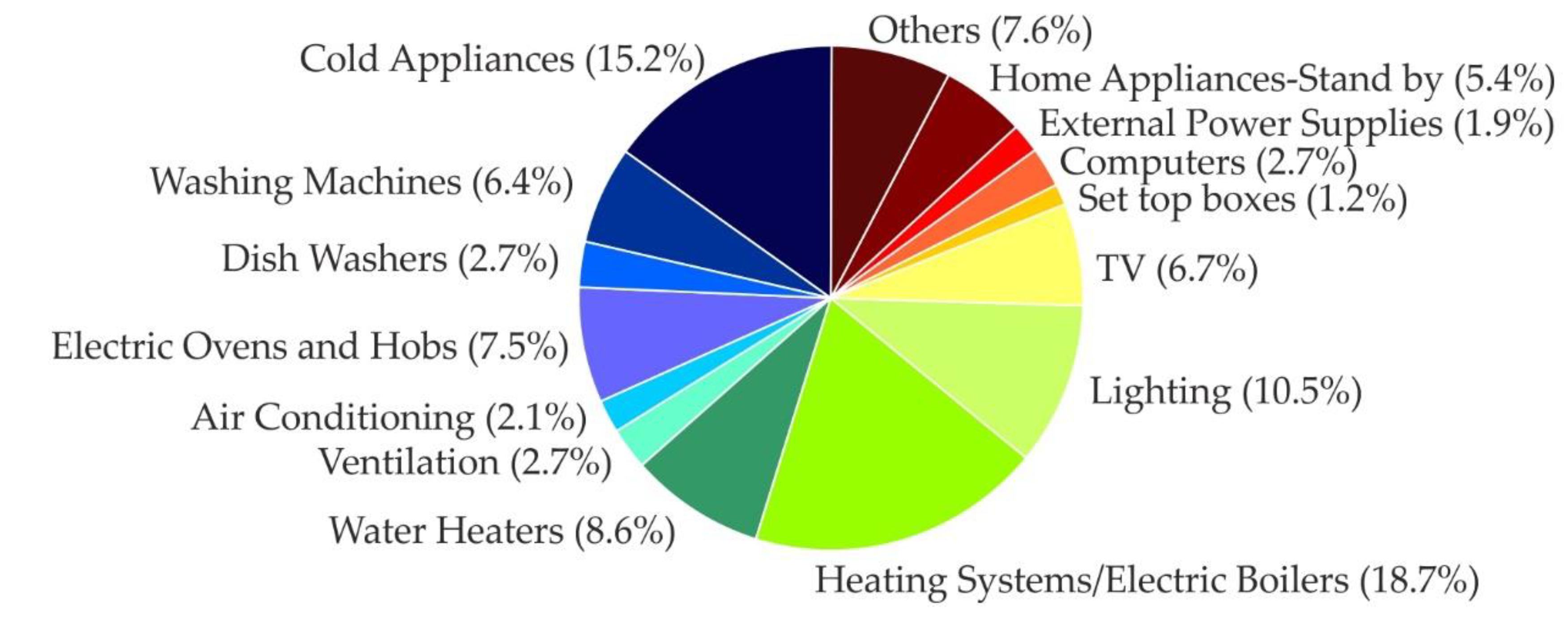
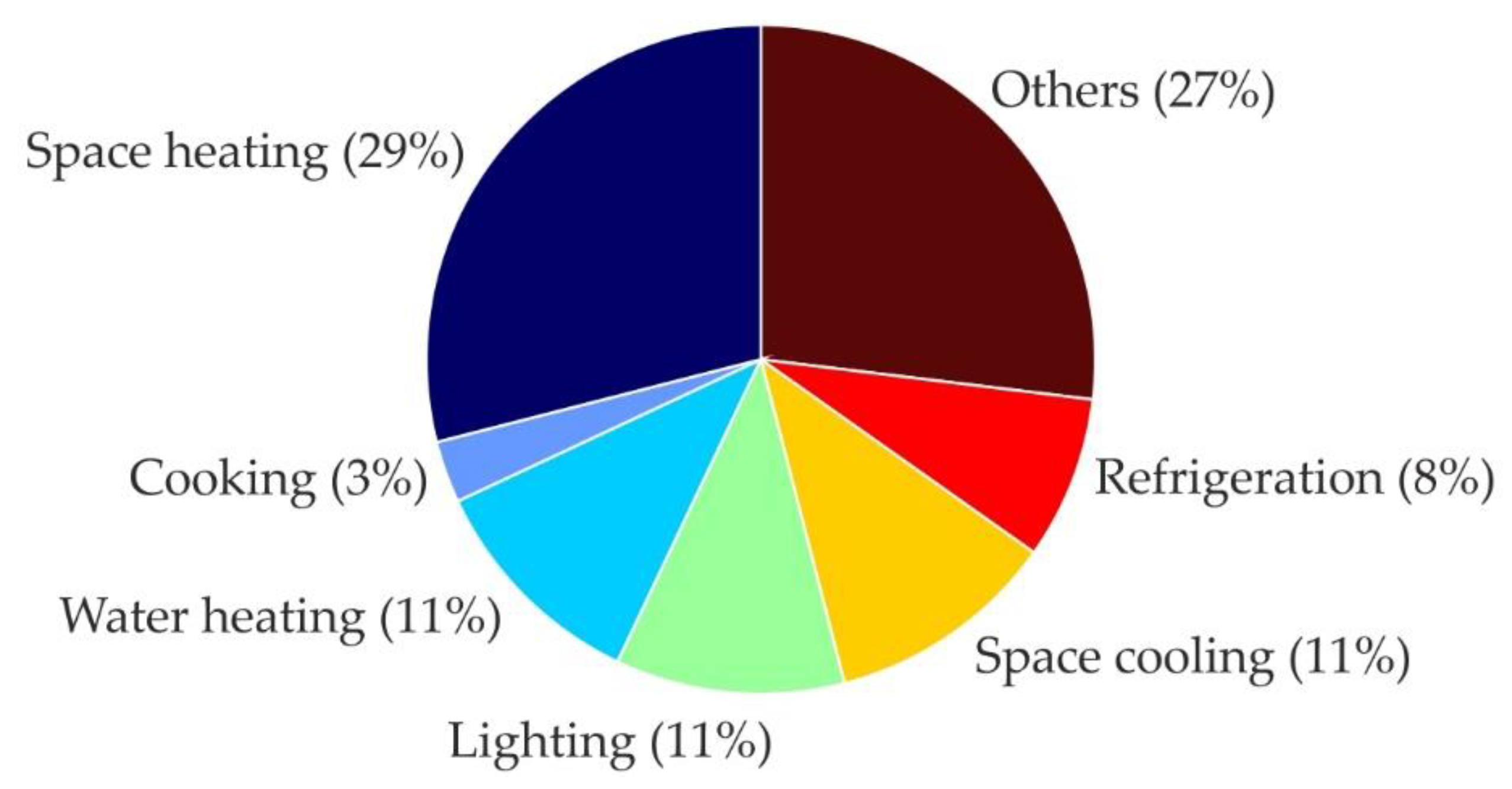
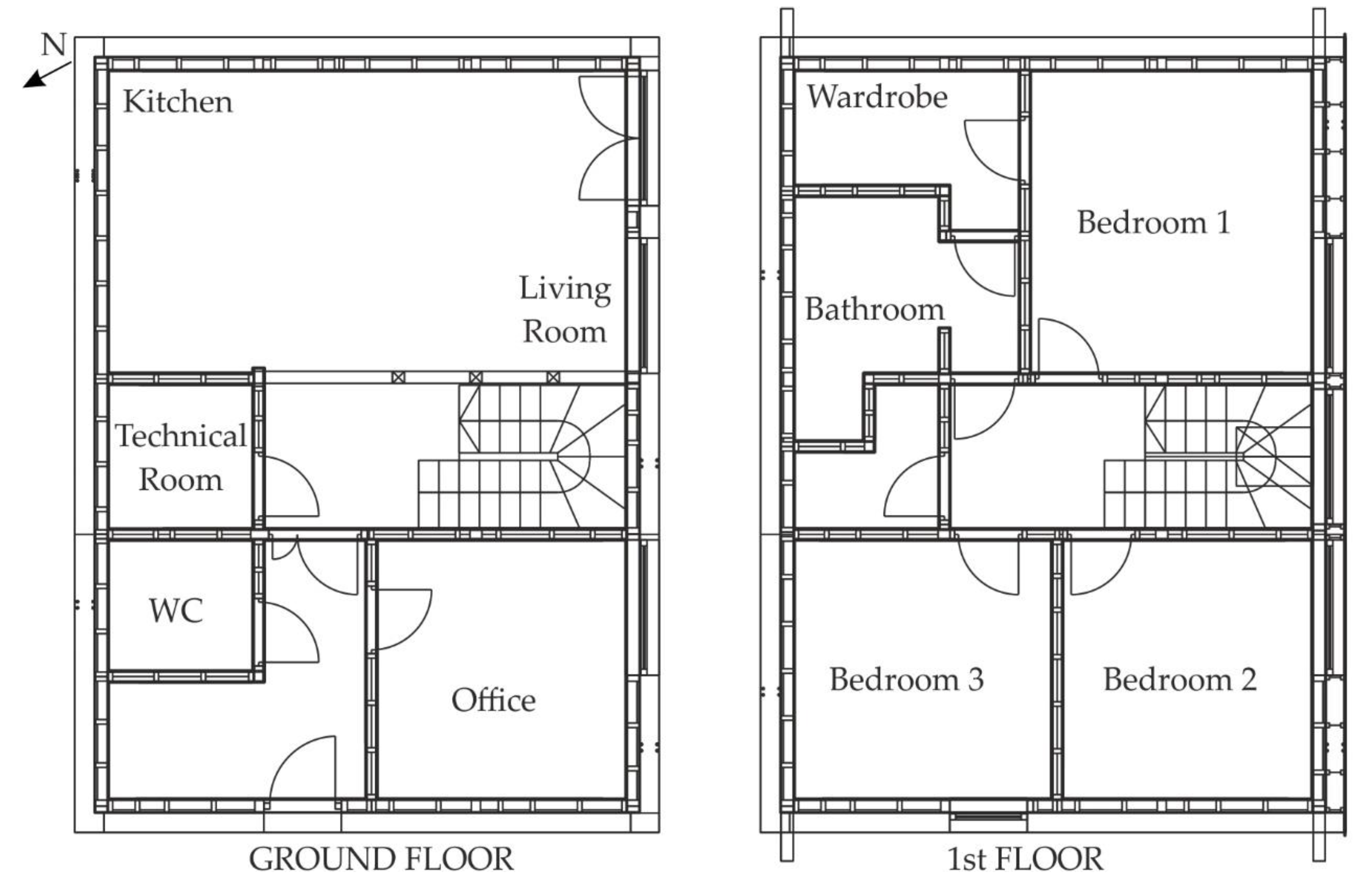
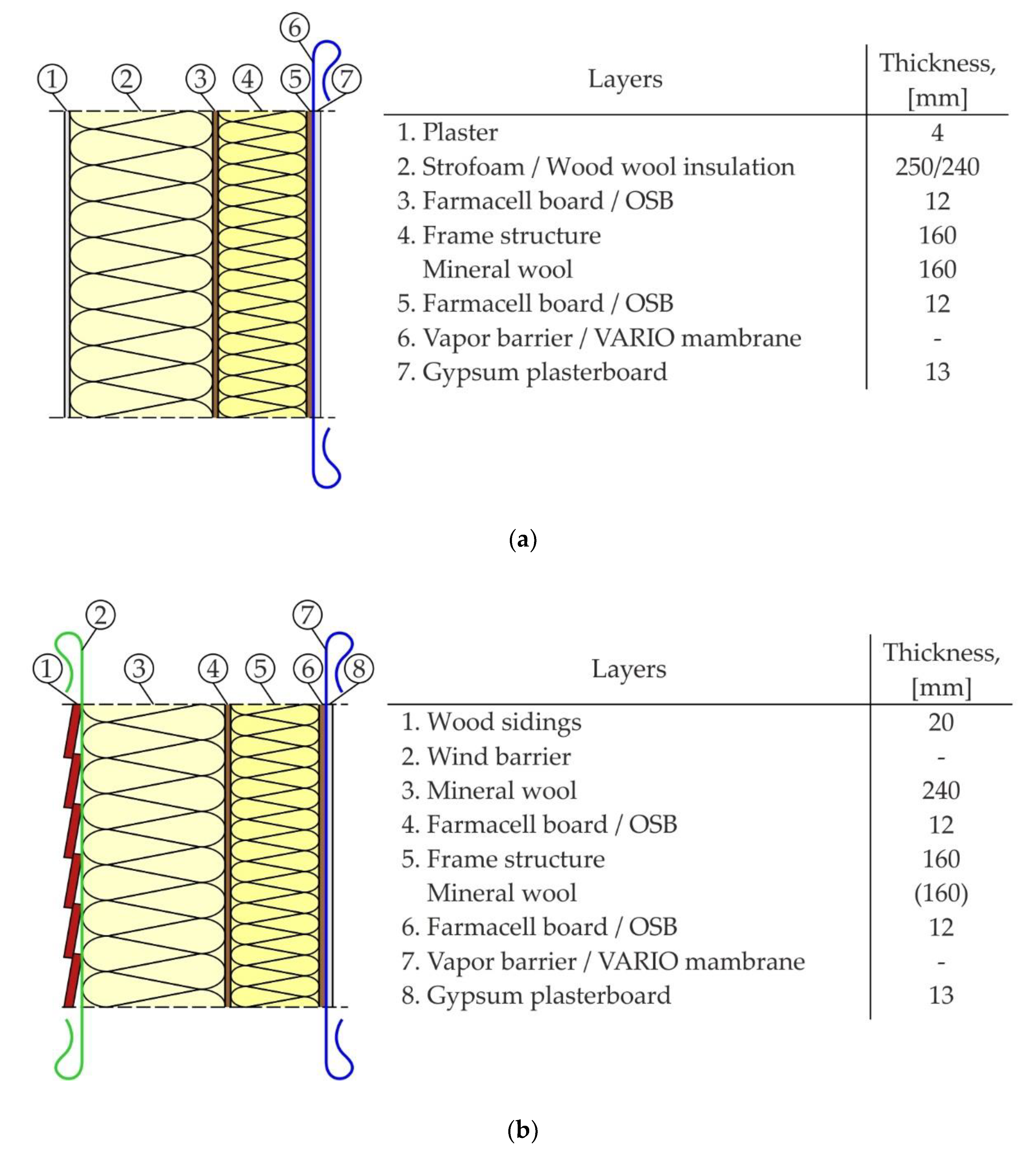
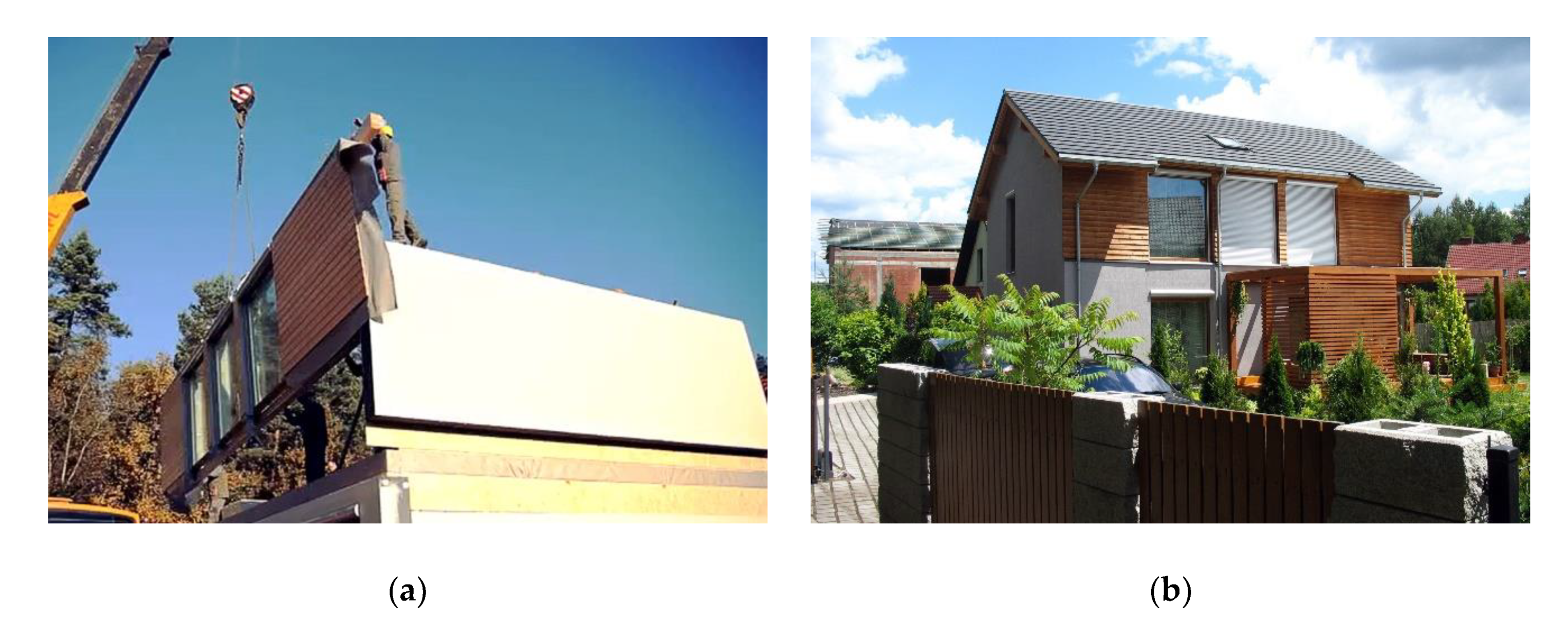
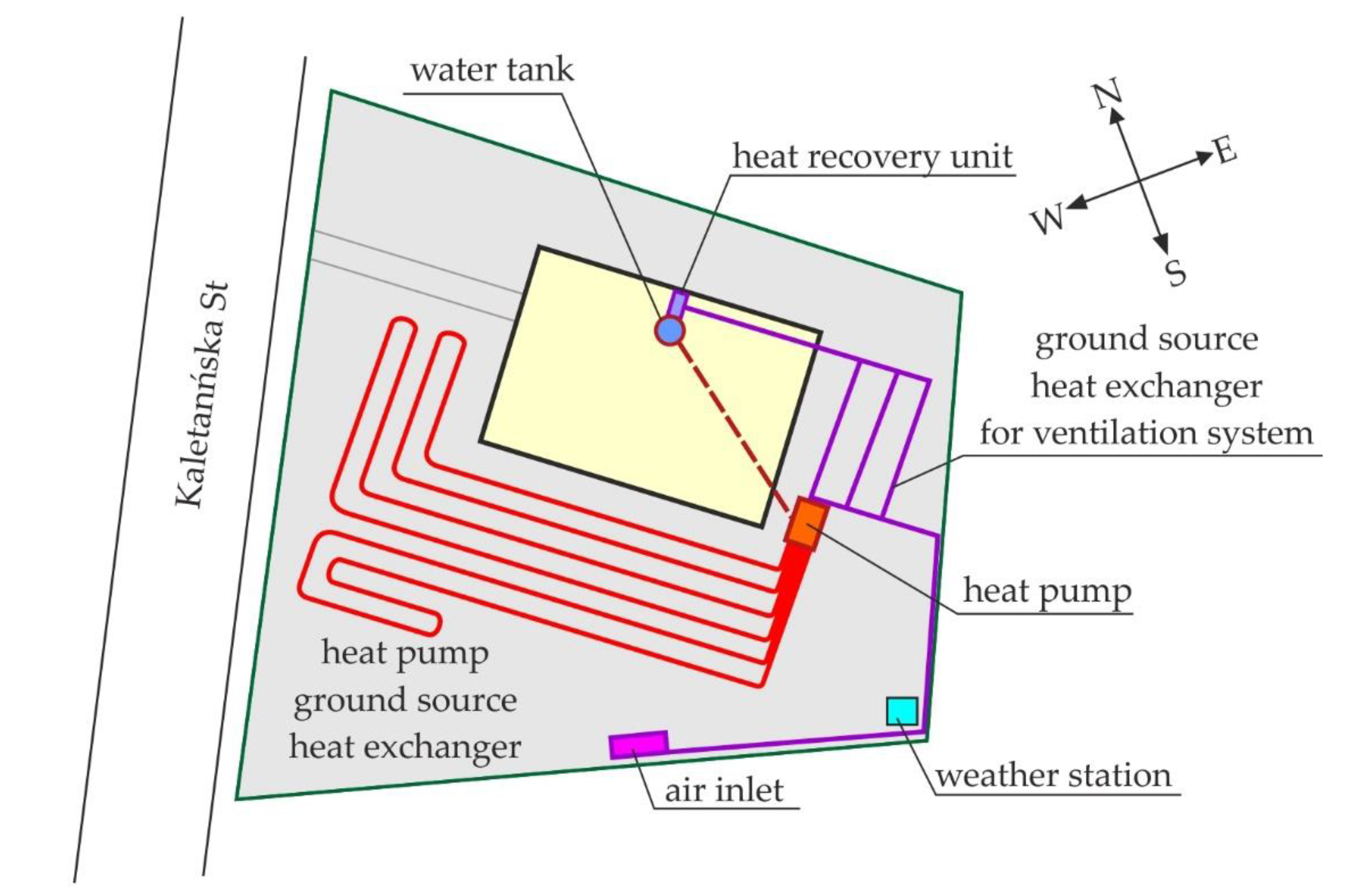
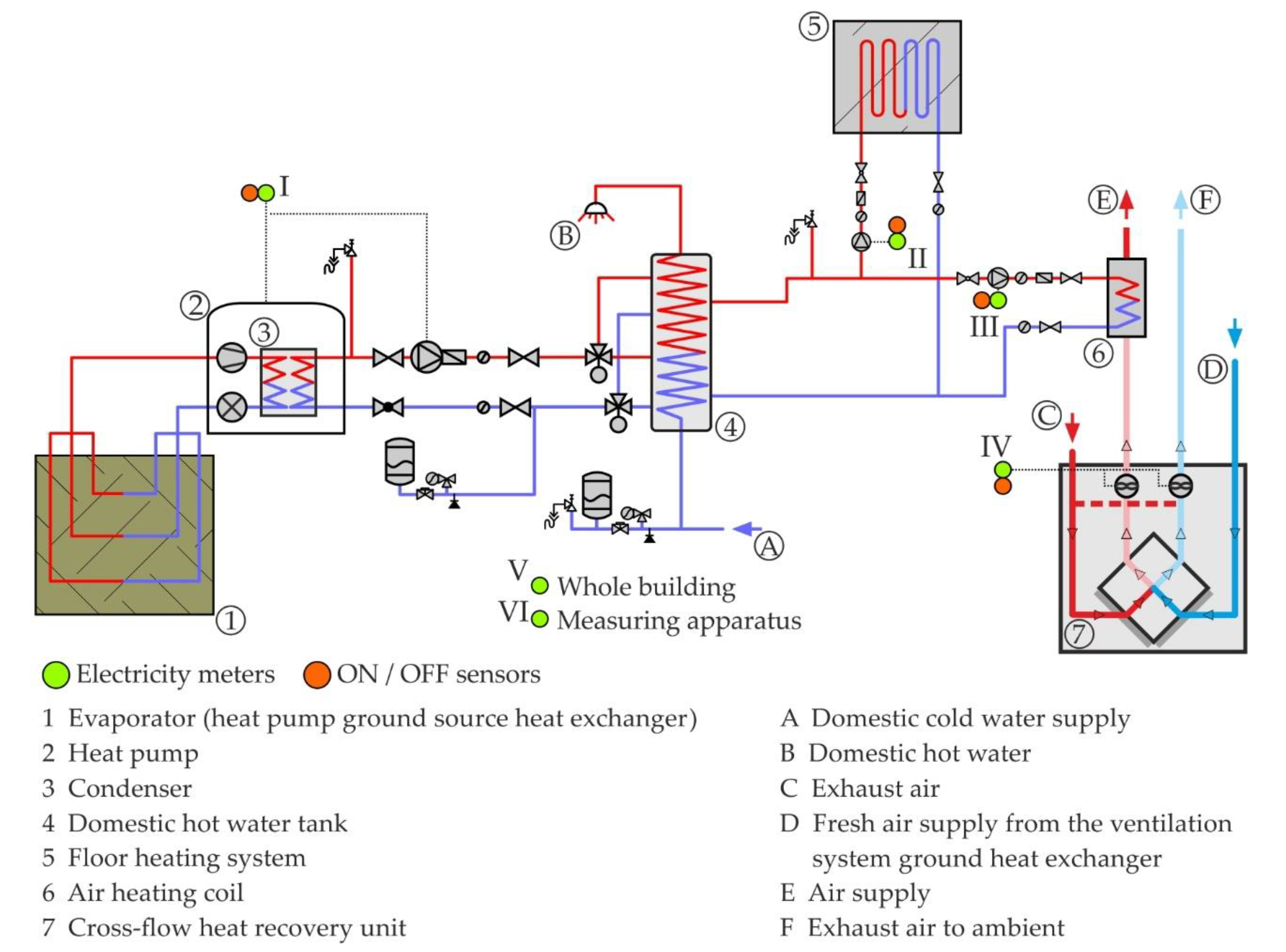
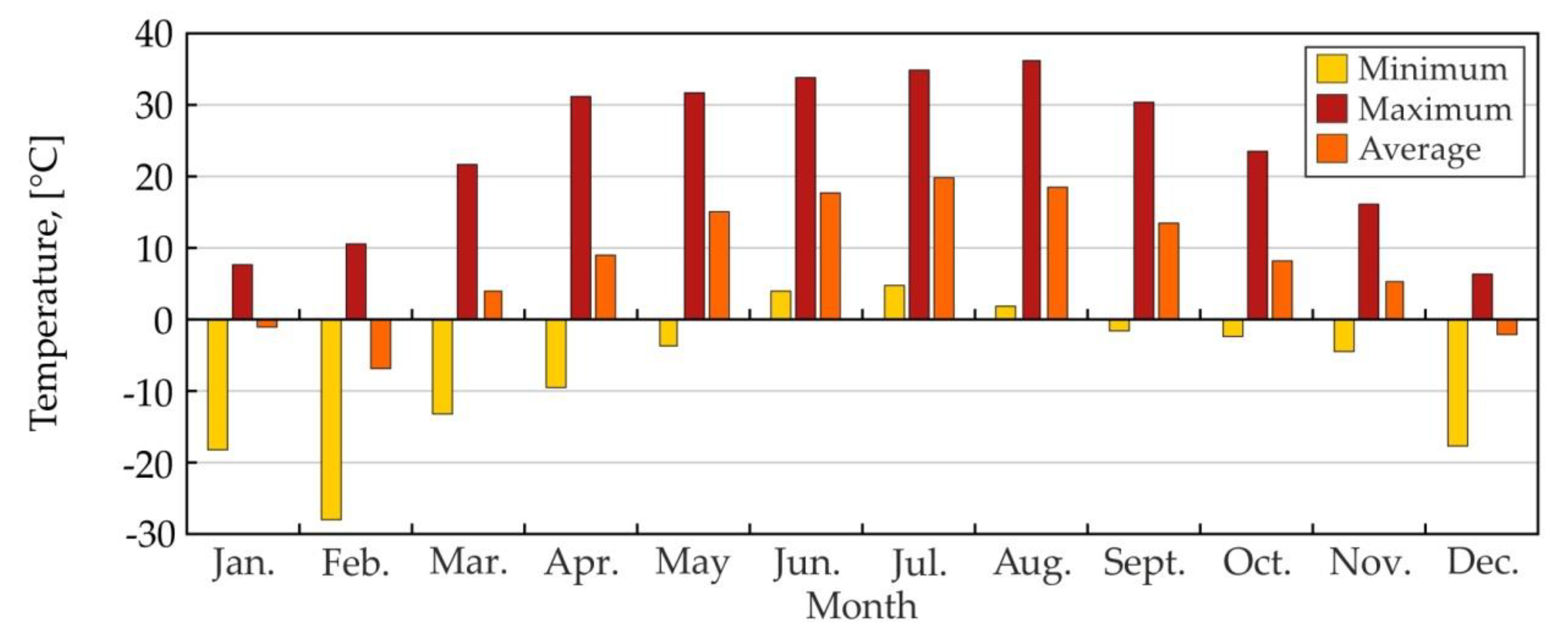
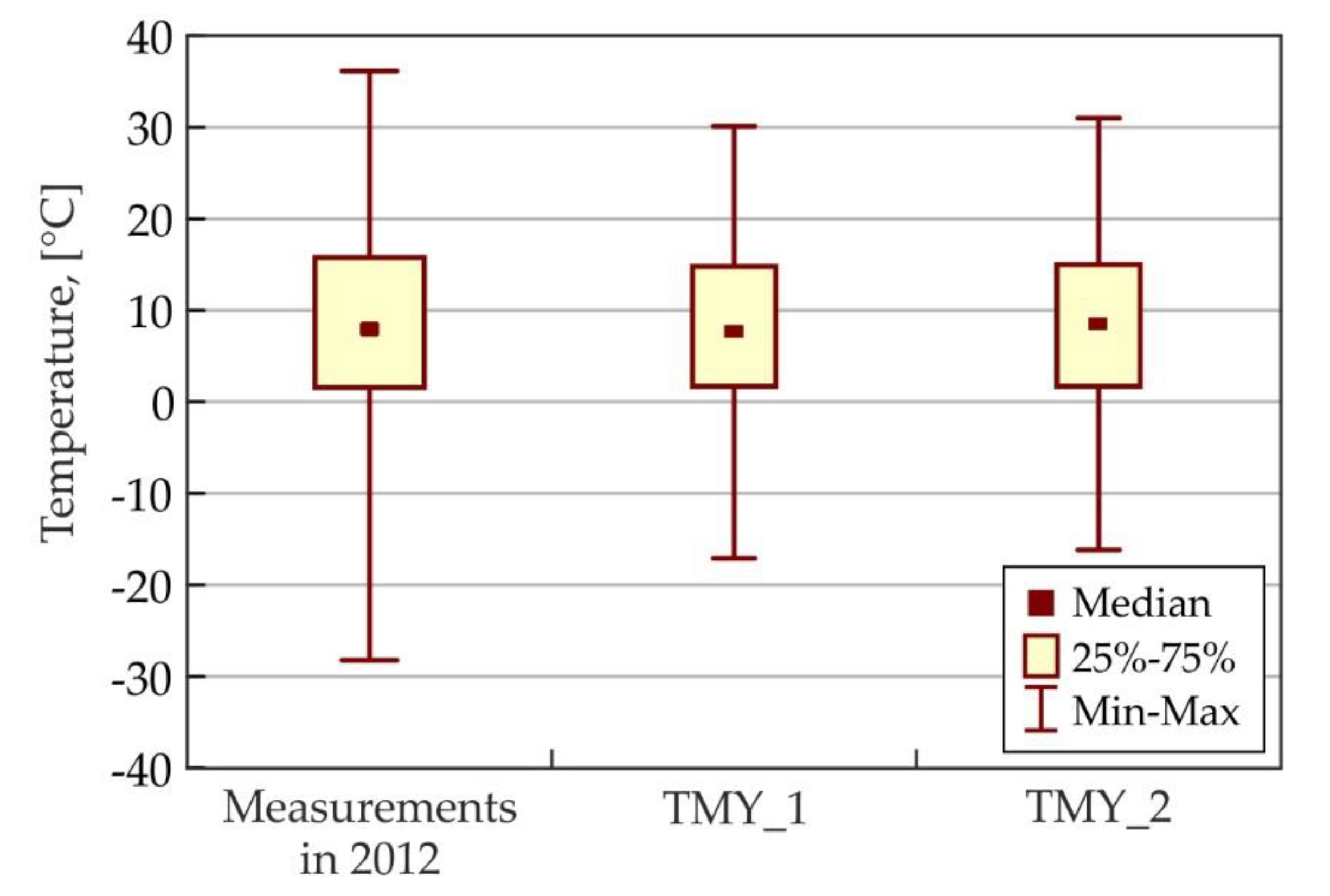
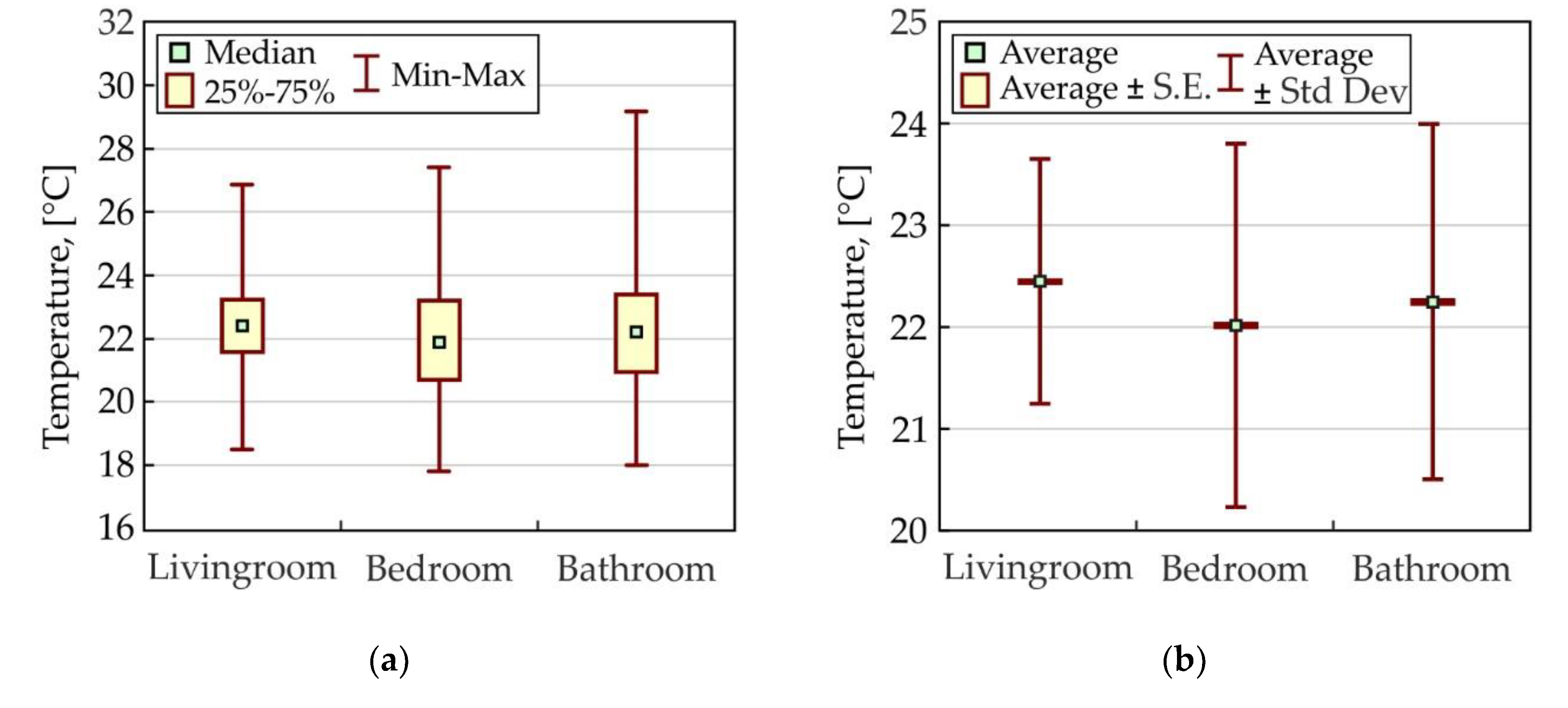

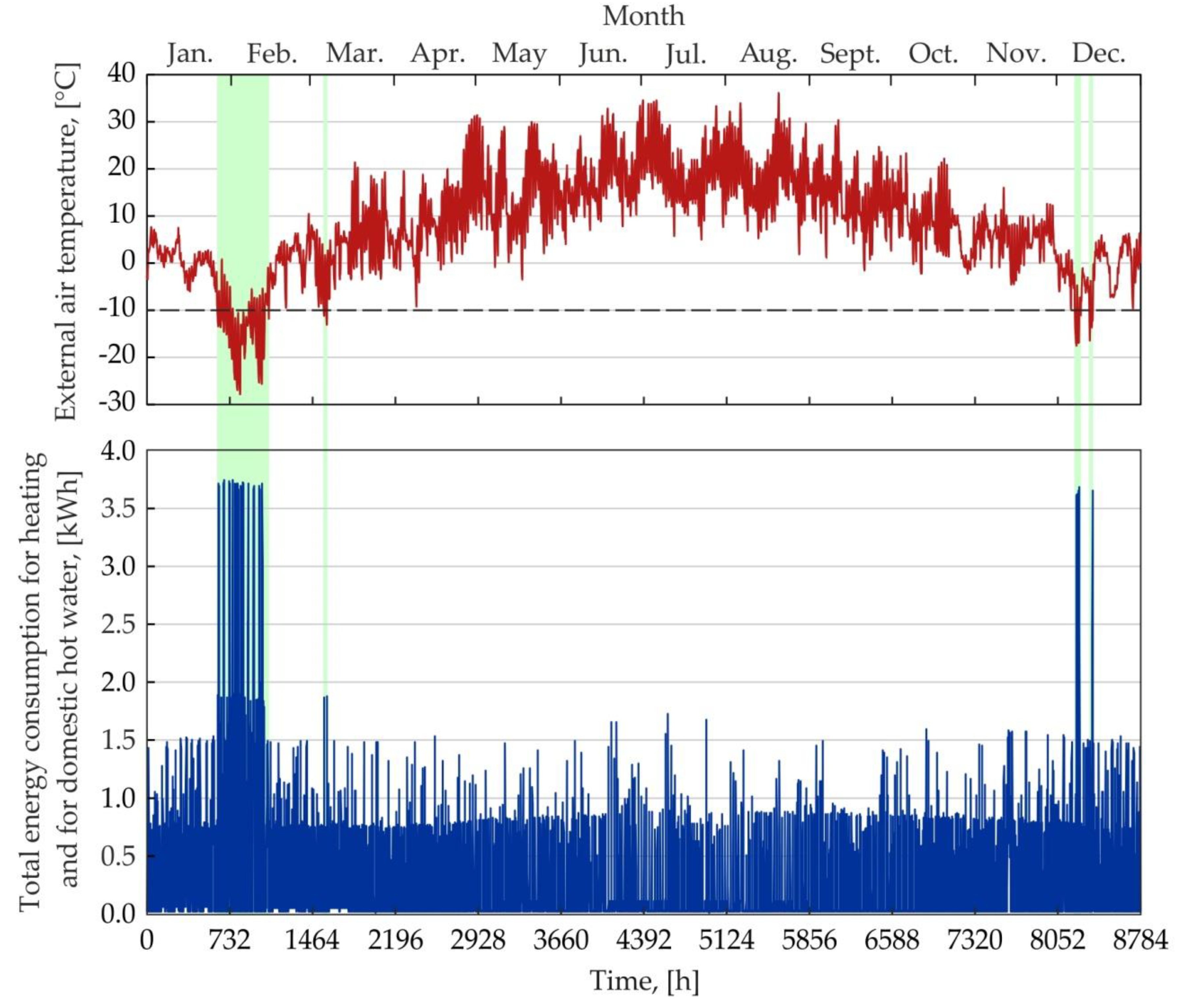
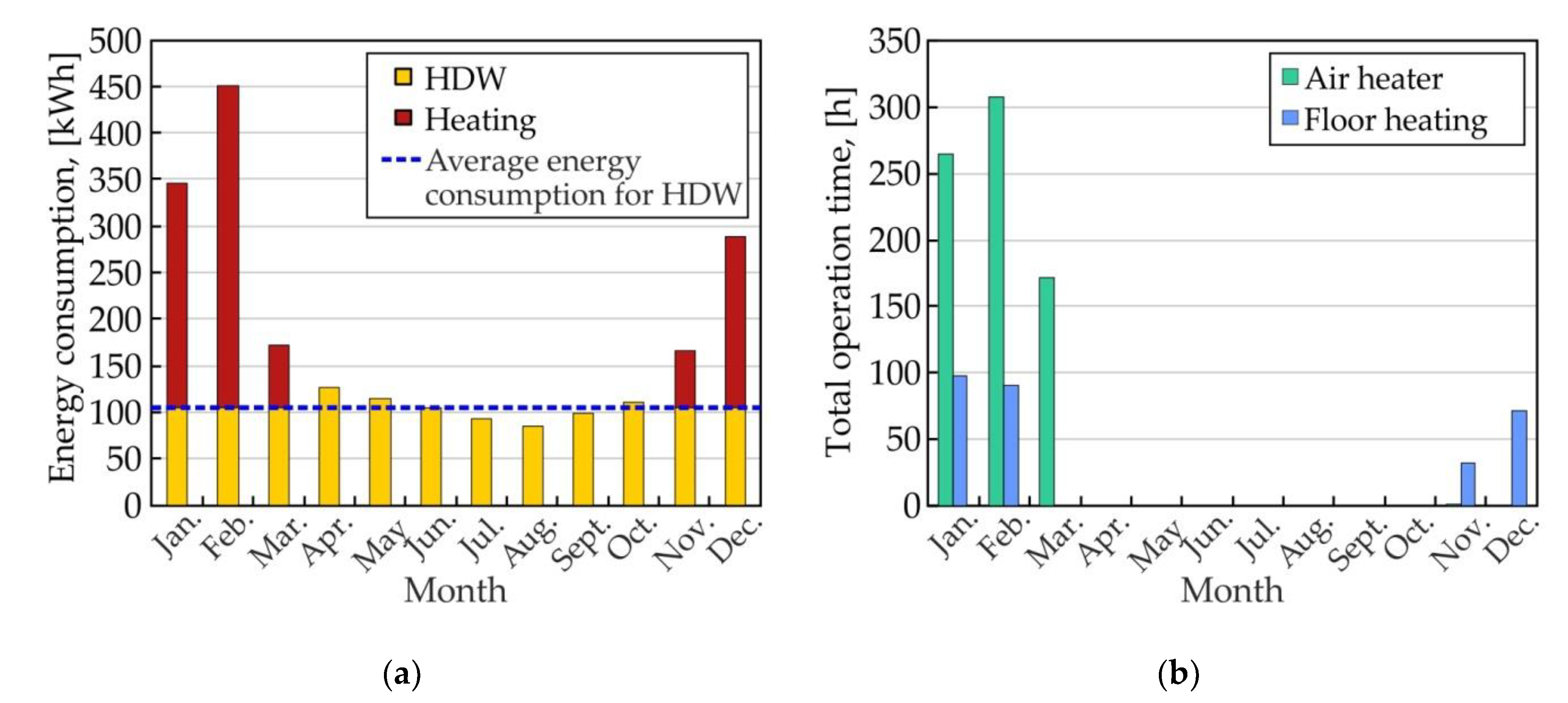
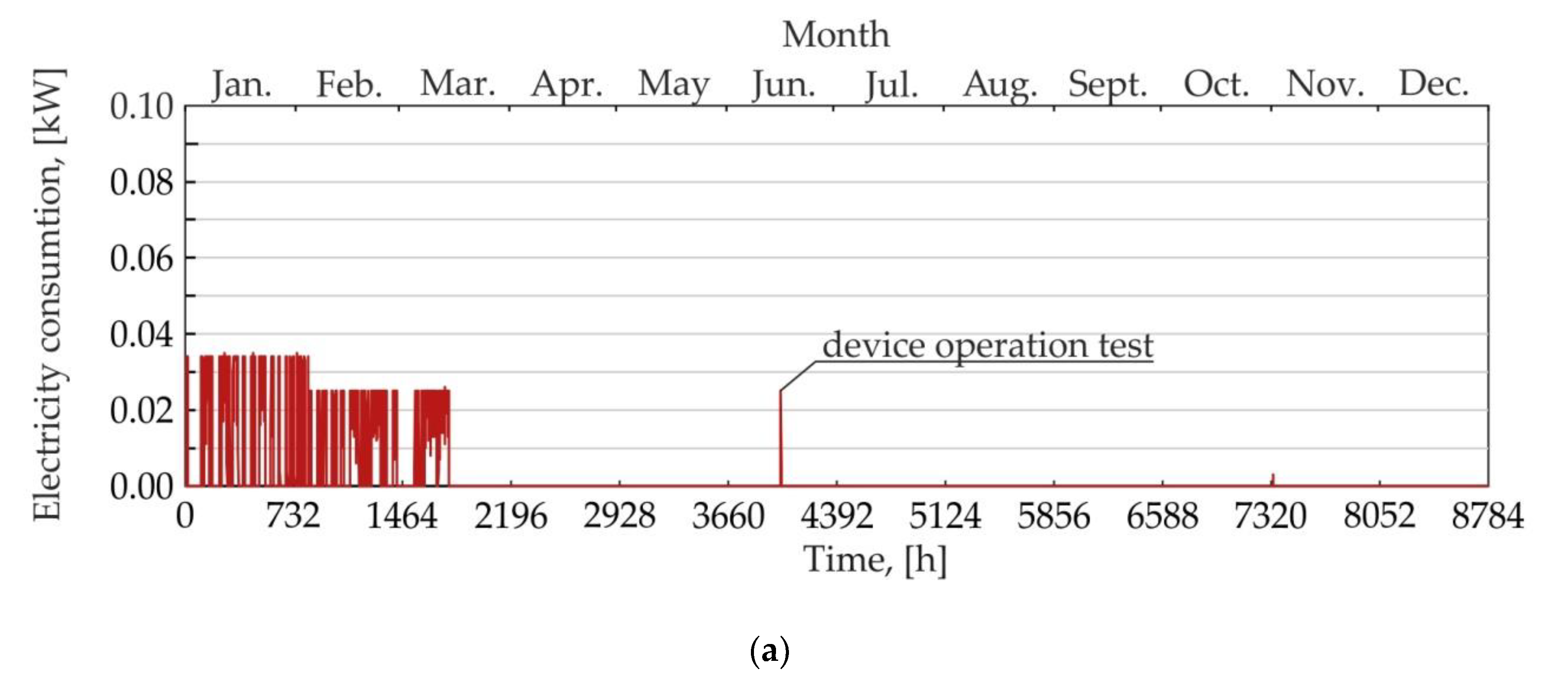
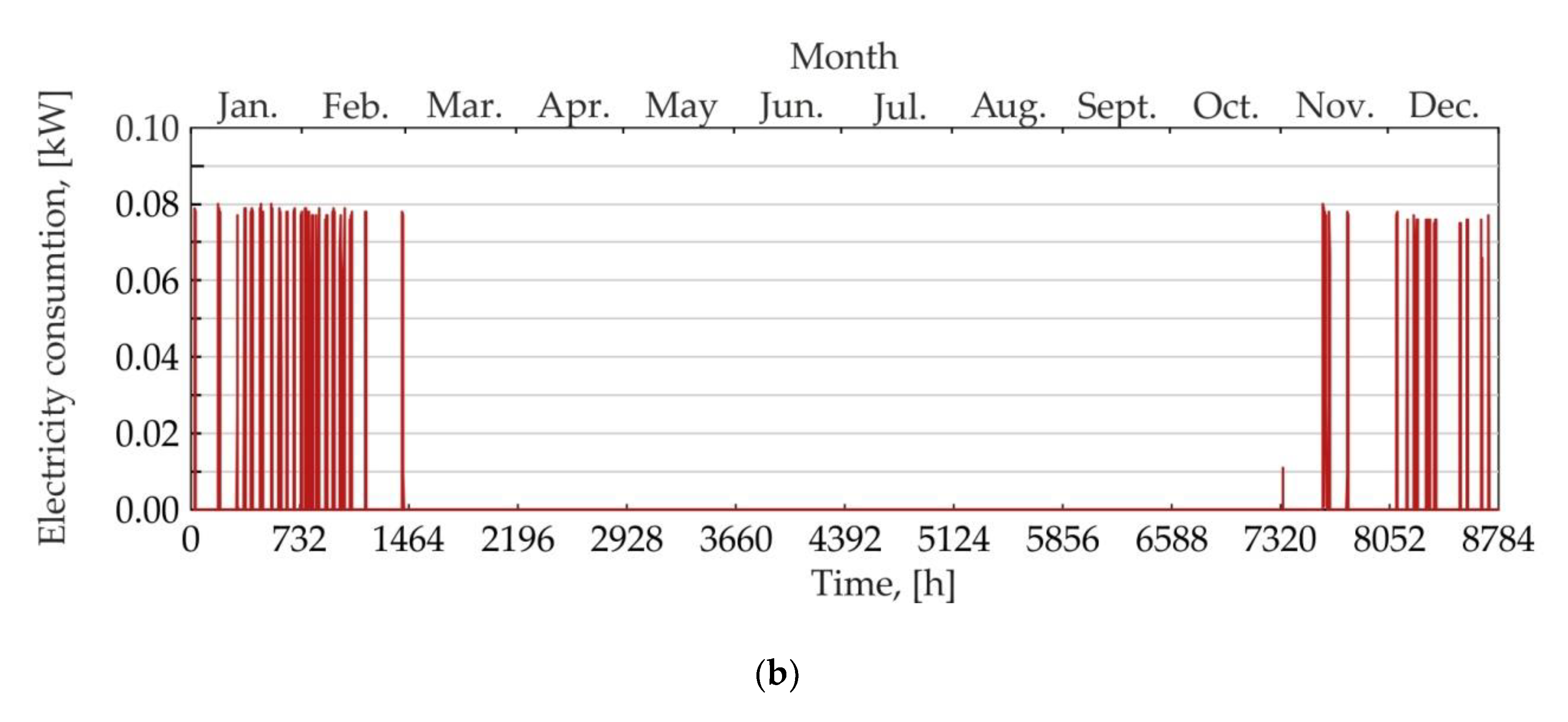

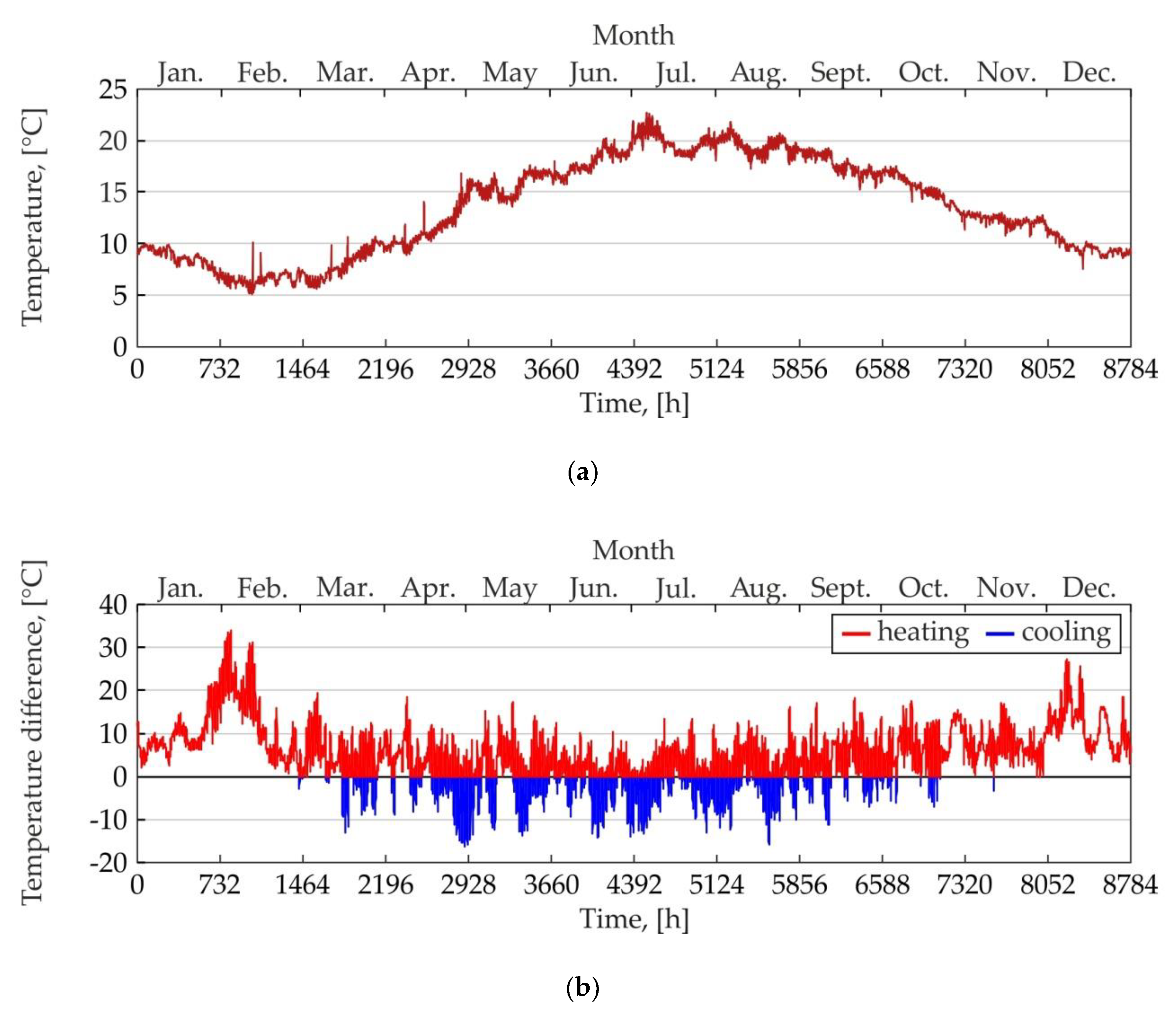
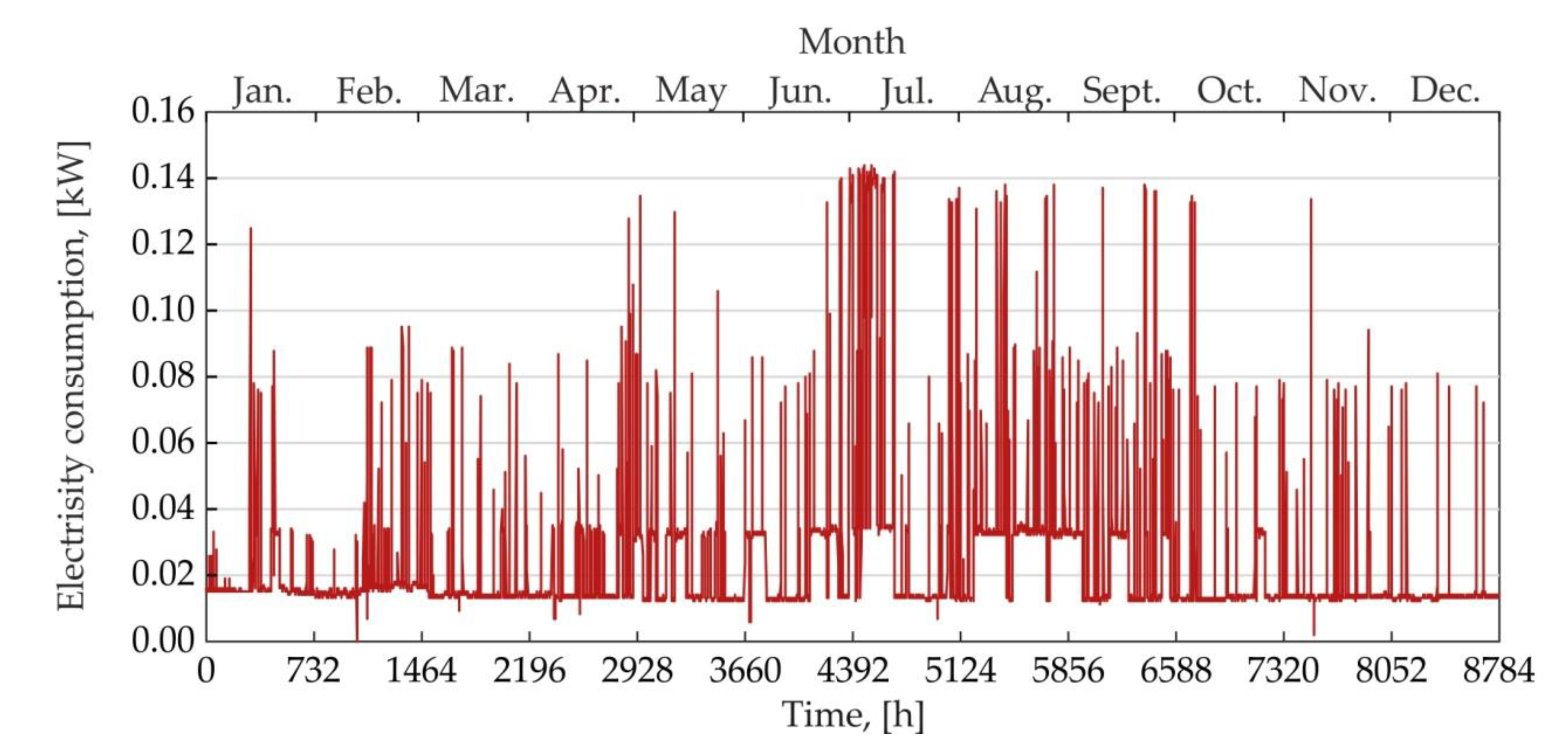
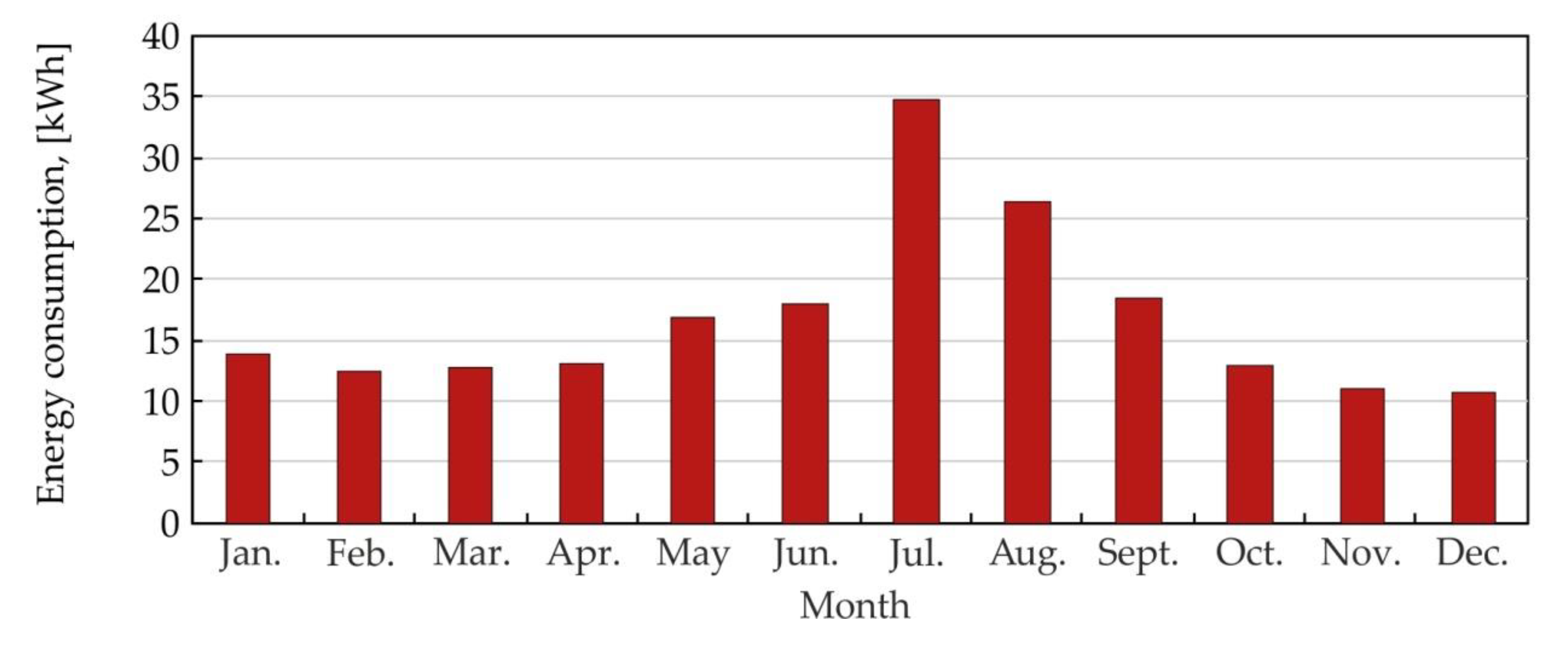
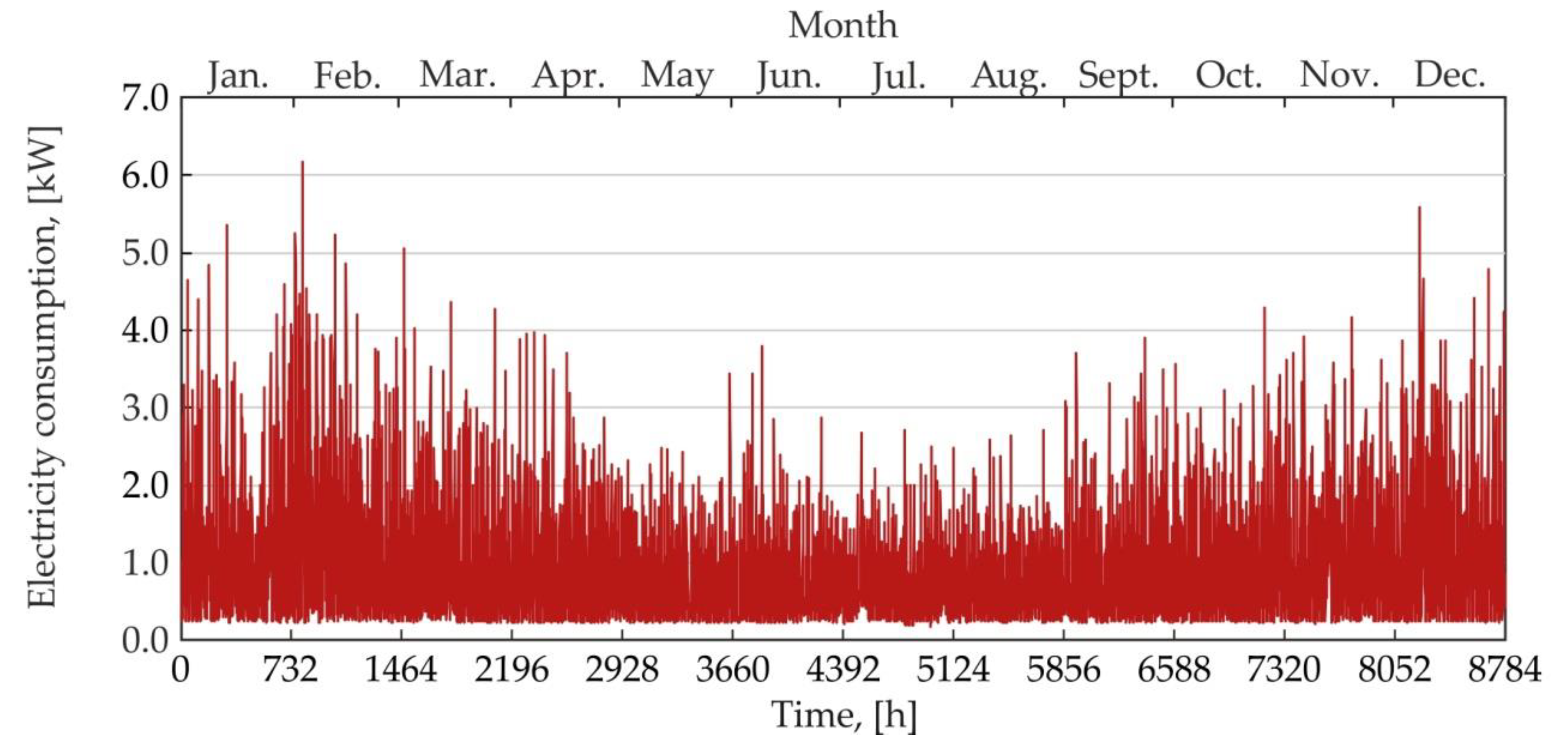


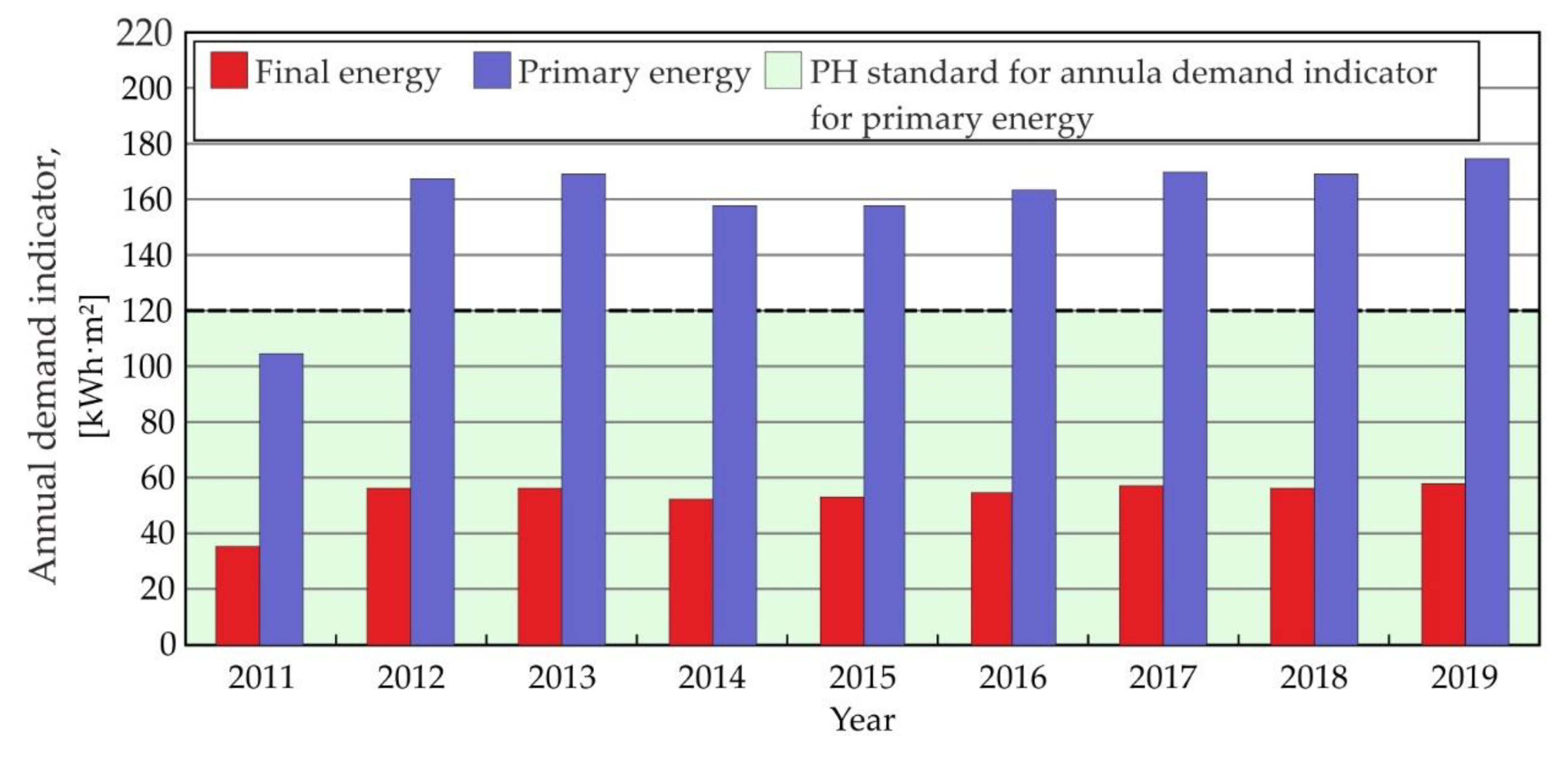
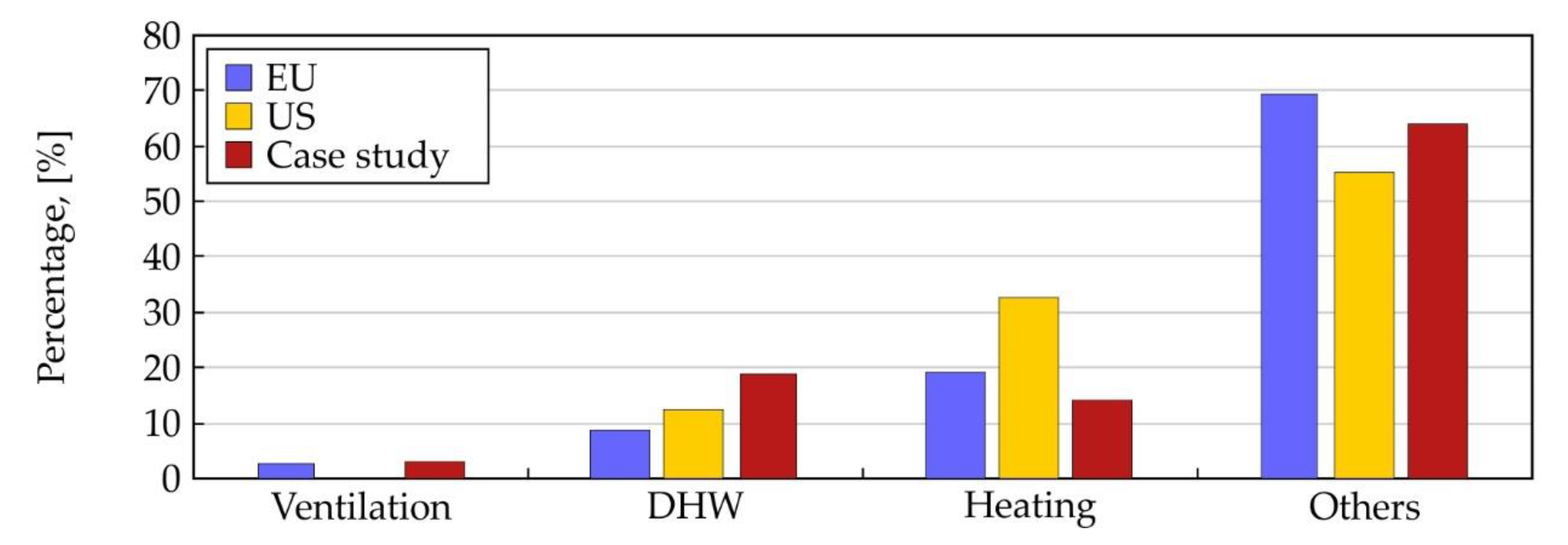
| Parameter | Limit Value |
|---|---|
| Heat transfer coefficient for opaque building components | <0.15 W·m−2·K−1 |
| Heat transfer coefficient for windows | <0.80 W·m−2·K−1 |
| Efficient heat recovery ventilation unit | >75% |
| Airtightness of the building | <0,6 h−1 |
| Heating energy demand | <15 kWh·m−2·year−1 |
| Primary energy demand (entire building) | <120 kWh·m−2·year−1 |
| Parameter | Value |
|---|---|
| Average heat transfer coefficient of opaque, outer building components | 0.08 W·m−2·K−1 |
| Heat transfer coefficient of windows (3 glass panes) Solar heat gain coefficient (average) | 0.74 W·m−2·K−1 0.6 |
| Efficient heat recovery ventilation unit | 93% |
| Airtightness of the building, ACH | 0.5 h−1 |
| Heating energy demand | 7.5 kWh·m−2 year−1 |
| Primary energy demand (entire building) | 104.4 kWh·m−2·year−1 |
| Heat Pump NEURA ProD6EuE® | Heat Recovery Unit Paul Novus (F) 300® | ||
|---|---|---|---|
| Parameter | Value | Parameter | Value |
| Refrigerant | R290 (3 kg), | Power consumption | 140 W |
| Heating power | 6241 kW | Air flow | 80–300 m³·h−1 |
| COP | 4,5 | Heat recovery efficiency | 93% |
| Mean power consumption | 1385 kW | Electrical efficiency | 0.24 Wh·m−3 |
| Supply voltage/frequency | 3 × 400/50 V/Hz | ||
| Min. evaporating temperature | −15 °C | ||
| Max. evaporating temperature | 20 °C | ||
| Min. supply temperature | 20 °C | ||
| Max. supply temperature | 55 °C | ||
| Max. operating pressure | 3 bar | ||
| Three-Phase Lem-10 m | Single-Phase Lem-02 m | ||
|---|---|---|---|
| Parameter | Value | Parameter | Value |
| Reference voltage | 3 × 230 V/400 V AC | Reference voltage | 230 V AC |
| Voltage tolerance | −15 ± 10% | Voltage tolerance | −15 ± 10% |
| Rated frequency | 50/60 Hz | Rated frequency | 50/60 Hz |
| Self-consumption | 2 W | Self-consumption | 0.4 W |
| Measurement accuracy | (IEC61036): class 1 | Measurement accuracy | (IEC61036): class 1 |
| Operation temperature | −10 ± 50 °C | Operation temperature | −10 ± 50 °C |
| Impulses per kWh | 400 | Impulses per kWh | 1000 |
© 2020 by the authors. Licensee MDPI, Basel, Switzerland. This article is an open access article distributed under the terms and conditions of the Creative Commons Attribution (CC BY) license (http://creativecommons.org/licenses/by/4.0/).
Share and Cite
Wąs, K.; Radoń, J.; Sadłowska-Sałęga, A. Maintenance of Passive House Standard in the Light of Long-Term Study on Energy Use in a Prefabricated Lightweight Passive House in Central Europe. Energies 2020, 13, 2801. https://doi.org/10.3390/en13112801
Wąs K, Radoń J, Sadłowska-Sałęga A. Maintenance of Passive House Standard in the Light of Long-Term Study on Energy Use in a Prefabricated Lightweight Passive House in Central Europe. Energies. 2020; 13(11):2801. https://doi.org/10.3390/en13112801
Chicago/Turabian StyleWąs, Krzysztof, Jan Radoń, and Agnieszka Sadłowska-Sałęga. 2020. "Maintenance of Passive House Standard in the Light of Long-Term Study on Energy Use in a Prefabricated Lightweight Passive House in Central Europe" Energies 13, no. 11: 2801. https://doi.org/10.3390/en13112801
APA StyleWąs, K., Radoń, J., & Sadłowska-Sałęga, A. (2020). Maintenance of Passive House Standard in the Light of Long-Term Study on Energy Use in a Prefabricated Lightweight Passive House in Central Europe. Energies, 13(11), 2801. https://doi.org/10.3390/en13112801





